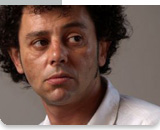 |
Ausstellung
SA DISTANCE / From a Distance
Konzept+Umsetzung:
 Hassan ABDELGHANI Hassan ABDELGHANI
Nachmittags bei schönem Wetter macht die lebende Bevölkerung bei den Toten Besuch und entziffert ihre eigenen Namen auf deren Steinplatten: Ähnlich wie die Stadt der Lebenden vermittelt auch diese eine Geschichte von Mühen, Ärgernissen, Illusionen, Gefühlen; nur dass hier alles notwendig geworden, dem Zufall entzogen, in Fächer gebracht und geordnet ist. Und um sich sicher zu fühlen, muss das Laudomia der Toten die Erklärung seiner selbst suchen, auch auf die Gefahr hin, entweder mehr oder weniger zu bekommen: Erklärungen für mehr als ein Laudomia, für andersgeartete Städte, die hätten sein können und nicht gewesen sind, oder halbe, widersprüchliche, enttäuschende Begründungen.
Italo Calvino, Die unsichtbaren Städte
"From a distance" the photographer's eye has been eager to come closer to the cities and meet their people. However, he got closer to the town by visiting his city of the dead.
The long deceased faces of Pula and Judenburg, mixed in their matching fates and deaths, are revived in the Universal Life After Life by palimpsests and ceramic portrait-ovals, which he decided to photograph devotedly, as if creating the portraits anew.
What did the photographer recognize in these portraits of portraits from his photograper’s distance?
He identified the category of duplicity, the ability to circumscribe life through death.
He recognized the vibrant city that breathes in the dead city and vice versa, the city of the dead that pulsates in the living.
He realized Calvino’s and also his own Laodamia of the living which searches for elucidation about herself in the dead Laodamia, even at the risk of finding more or less of what was expected: an explanation of the existence of more than one Laodamia.
Photographed images, portraits of portraits made him determined to once again capture one moment at the time.
Life after life. To perpetuate the death that lives. Oxymoron: a living death.
Although he knew that his distance is a kind of luxury and safety belt- a cold protective aura that will take him on a walk as an accidental traveler, un-cracked by the vistas of the city, his longing glance made every pressure on the trigger of the cold appliance exceed those cold boundaries and establish chapters of immediate familiarity and recognition. This way, in the image of a femme fatale with a bright red lipstick and her broken gaze on the cracked ceramic oval he has recognized his own neighbor whose flirtatious eyes one winter fell victims to the arms of her raging husband who, with a post festum slap, ended the fiery affair with the officer whose portrait, with a spry natty mustache and in all his military grandeur, is now just a few beds away from her.
In the mildly surprised look of a boy that already a whole century, from the worn off portrait, anxiously fears whether the war will soon end, just like his lung ailment that caused the heart of the monarchy move him to the beneficial Adriatic, the author recognized and portrayed again his best childhood friend who, same as the other boy, never returned to his school after summer holidays. In a three-year old girl, placed in the hearse in a formal white dress, stiff, with eyes wide open (added later in the atelier of the city's best photographer), he identified the deceased sister of his grandmother that never came to take pictures of her short life, and this photo of her non-aliveness was the only thing that reminded her family and held them in conjunction with that sad little life almost no one not even remembers any more. And so on, from one person to another, the photographer was recognizing and deciphering the codes of life and death that had crept him into the secret labyrinths of his and Calvino’s Laodamia.
From the distance from which his eye, heart and mind longed to abolish it, the photographer’s craving has been, for an instant, perfectly able to decode the redundancy of the fugue form of life. At the end of his journey the photographer is, instead by an oval, welcomed by a mirror. In his reflection, however, he sees an old photo-camera.
Almost the same as the one that was once dragged along by a young Austro-Hungarian soldier (buried just next to the girl in a white dress) whom a twist of fate, instead as a bohemian in the fashionable world of Paris, made his life start as his afterlife, to “live” it on the only preserved self-portrait-a photography abducted from an un-crannied celluloid tape covered by dirt from the trenches of Galicia.
Paola Orlic

|
 |

Hassan Abdelghani
[* 1965, Osijek/Kroatien, aufgewachsen in Kairo/ Ägypten] Fotograf, Gründer des Kunstvereins "Film and Film" und Betreiber der Galerie "Makina" in Pula, lebt und arbeitet in Pula.
Ende der 1980er Jahre wanderte Abdelghani nach Kopenhagen/Dänemark aus, wo er 1991 seine Fotografieausbildung bendete und 1998 die private Fotoschule "Global Fotoskole" gründete.
Nach seiner Rückkehr nach Kroatien, arbeitete er jahrelang als Leiter der Fotoabteilungen am Zagreb-Film-Festival, am Pula-Film-Festival, am Motovun-Film-Festival, für Animafest und am Human Rights Film Festival.
Hassan Abdelghani hat zahlreiche Fotographie-Ausstellungen in Kroatien im Ausland organisiert, war Tei-lnehmer an Gruppenaus-stellungen und hatte Perso-nalen in Dänemark, Italien, Kroatien und Bosnien.
Er ist Gastprofessor an der Osijek Akademie und an der Sarajevo-Film-Akademie.
|
|

